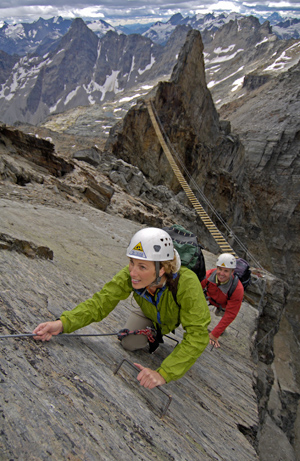Originally Topher Donahue on Tue, Jan 26, 2010
 By the late 19th century, seeking adventure in the mountains was in vogue in Europe but, with the equipment and technique of the day, difficult sections of popular climbs were slow and dangerous. Climbers began installing permanent metal fixtures (ladders, cables, rungs and bridges) to bypass these hazards.
By the late 19th century, seeking adventure in the mountains was in vogue in Europe but, with the equipment and technique of the day, difficult sections of popular climbs were slow and dangerous. Climbers began installing permanent metal fixtures (ladders, cables, rungs and bridges) to bypass these hazards.
The first recreational era of the Via Ferrata lasted only a few years. By early in the 20th century, the Alps became a primary battleground of World War I. The Italians positioned their front line across their most rugged mountains, the Dolomites, a region now famous for scenic skiing, climbing and hiking among huge spires and rock walls. The Via Ferrata were built to give the military access to the higher ground and strategic sites where the mountains provided natural, formidable, defenses. Several old military Via Ferrata were rebuilt and are maintained by the Italian Alpine Club. Adventurers in the Dolomites now enjoy the most exposed museum on the planet with a Via Ferrata alongside trenches and other relics of mountain warfare.
In the late 1800s, the Americans also installed cables and ladders to give tourists access to difficult and popular summits. Both the Cables Routes on Colorado’s Longs Peak and California’s Half Dome were drilled into precipitous granite peaks. Longs Peak’s Via Ferrata was prone to rockfall and was later removed for safety reasons, but the Sierra Club rebuilt the Half Dome cables to withstand thousands of ascents each summer.
There are few places in North America where Via Ferrata construction is appropriate for land management or the wilderness ethic. Mountain climbers are some of the more outspoken opponents of the Via Ferrata, as modern climbing equipment and technique make virtually any peak accessible. Ironically, modern sport climbs are arguably Via Ferrata, with metal expansion bolts drilled into the rock at frequent intervals to allow human passage.
One of the airiest Via Ferratas on the planet is located deep in the Purcell Range of the Columbia Mountains of British Columbia. Just a few kilometers north of the Bugaboos, where heli-skiing was born 45 years earlier, the guides of CMH Bobbie Burns have constructed the Mount Nimbus Via Ferrata. It follows a narrow path along a knife-edged ridge that leads over the twin-spired summit of Mt. Nimbus, and crosses a 60-meter suspension bridge between the two peaks. (See a video here.)
The idea for the Mt. Nimbus Via Ferrata began with a mountain version of a summer camp-style ropes course built near the CMH Bobbie Burns Lodge. This Adventure Trail takes guests through a thrilling series of zip lines and small Via Ferrata installations over the glacial-tinted turquoise waters of Vowell Creek . When CMH guests started booking trips to the Bobbie Burns primarily for the the Adventure Trail, the guides were reminded that people love safe, thrilling mountain adventures. The guides realized adventures for everyday people could be created with the addition of short Via Ferrata sections to surmount overhanging rock or bypass dangerous sections. The guides then built a short Via Ferrata on Mt. Syphax to connect a long, classic day of easy climbing.
Realizing the potential, the Bobbie Burns guides visited Europe to learn how to install a full-scale Via Ferrata and returned to equip Mt. Nimbus. Mt Nimbus has since been featured in National Geographic Adventure Magazine, The Robb Report, The Los Angeles Times, Men’s Journal, and other print and online publications.
Helicopter is the only realistic way to access Mt Nimbus. It is located in the most remote part of the Purcell Mountains and is an exclusive experience for participants in the CMH High-Flying Adventure program.